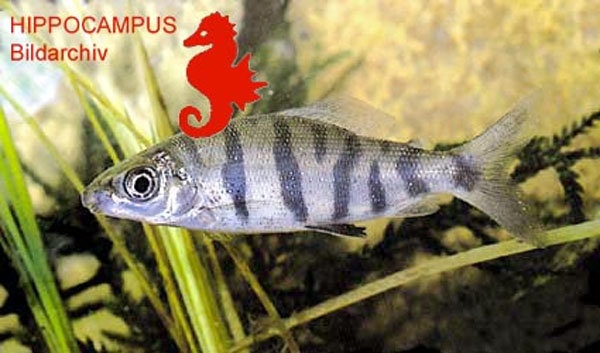|
Dorsal spines (total): 0-0; Dorsal soft rays (total): 21-25; Anal spines: 0-0; Anal soft rays: 12-14. Diagnosis: Within the Congo basin, Distichodus antonii can be distinguished from D. affinis, D. altus, D. decemmaculatus, D. noboli, D. notospilus and D. teugelsi by its higher total number of lateral line scales, 52-64 vs. less than 46 in the other species; and from D. maculatus by the absence of large, dark spots all over the body, 9-14 vertical dark bars instead, and a higher number of dorsal fin rays, 21-25 vs. 19-21 (Ref. 96324). Distichodus antonii can be separated from all remaining Congo species by its terminal, vs. inferior, mouth, with the exception of D. lusosso (which has a distinctive elongate snout and only 6 to 8 vertical, dark bars), and by its lower number of scales between the lateral line and the dorsal fin, 10-12 vs. 13-17 (Ref. 96324).
Description: Body relatively deep; dorsal head profile straight, dorsal body outline concave from posterior to head to end of dorsal fin, straight from end of dorsal to adipose fin, and convex from adipose to caudal fin; ventral head profile straight, concave from posterior to head to end of anal fin, and convex from end of anal to caudal fin (Ref. 96324). Head broad with nasal openings widely set apart, 10.1-26.5% of head length, and head relatively shallow, 35.2-67.2% of head length, although these characteristics are positively allometric; mouth terminal; snout not elongated; posterior edge of maxillary not passing nostrils; two rows of bicuspid teeth in each jaw (Ref. 96324, 122092). Origin of dorsal fin slightly in front of pelvic fin origin along vertical axis; distal margin dorsal fin straight or slightly concave, distal margin of anal fin straight to slightly convex; base and distal end of pelvic fin relatively far from vent; these distances are positive allometric, 21.0-33.6% of standard length and 3.9-18.0% of standard length respectively; pectoral and pelvic fin rays decreasing in length from outer to inner fin margin; adipose fin situated approximately half-way between dorsal and caudal fins; caudal peduncle deeper than long; caudal fin forked with two rounded lobes covered with numerous small scales except for translucent distal area (Ref. 96324).
Colouration: Body in vivo dark brown-olive, belly whitish; dorsal fin scattered with numerous small, dark spots; caudal fin dark brown or blackish; adipose fin with a well-marked black distal margin; pectoral fins uniform pale; pelvic fins uniform pale or with slightly darker fin ray borders; between 9 and 14 more or less distinct vertical dark bars on each flank that disappear with increasing size, starting to fade at 200 mm standard length, disappearing at about 250 mm standard length (Ref. 96324, 122092). Preserved specimens brownish with a lighter belly; the black margin of the adipose fin and vertical bars can be absent because of poor and/or long-term conservation (Ref. 96324). |
| The fry and juveniles of Distichodus antonii live in aquatic prairies and in plant fringes; adults feed in Echinochloa patches and live at the edge of streams along islands and even on the bottom in the middle of the stream (Ref. 96324). The species is a phytophagous species; stomachs almost always contain plant fragments, with easily recognizable twigs and leaves of Echinochloa, which comprises the largest part of their diet (Ref. 96324). It has two annual periods of reproduction and spawning and egg deposition have to take place at the border of the stream, just before the flood. Maximum reported total length is 550 mm (Ref. 1878), although it is stated it can reach a size of more than 800 mm (Ref. 7094, 96324). Maximum weight was recorded at nearly 10 kg (Ref. 7094). |

